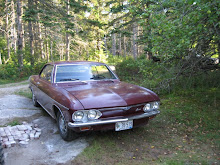The build plate on the car says it was built in February, 1980, and the warranty card indicates it was purchased in March, 1981, by a Mark Kelly at Tom Connelly Pontiac in Norwood, MA. A family member, Norman Kelly, brought it to his seasonal home in Canton, ME, where it spent a lot of time in his barn before selling it to Russell Tracy in the same town.
Russell owns a small repair garage and he bought it as a possible fun car for himself and wife Pamela. But he found he rarely drove it and, as a matter of fact, never registered it for the road. Russ put it up for sale a short while later and that's how Tim Hutchisen, the expert behind Penn Ridge Motors in Norway, ME, found the car. He liked what he saw but had no time to work on the car and declined to buy it.
When I went on the search for a sports car to replace my TR-7 Spider, I knew that finances would limit my options. Spitfires never fetch a high initial price and a rubber-bumper one, from mid - 1979 through 1980 [the last year of production] should cost even less. I had answered a number of Craigslist, online, even newspaper ads, in my search. I called Tim because I knew he was a Triumph specialist and because he might know of customer's cars for sale.
Tim recommended I look at this car because it was "unmolested." Indeed it's very original, including the disco-era "Pageant Blue" paint and black an white check interior seats. Combined with the rubber bumpers, it looked truly appalling compared to other sports cars under consideration: a '78 Spitfire, a '74 MG Midget or a '74 MGB.
Only one of these cars, the Midget, actually had any professional provenance; the others were owned by casual enthusiasts who knew little of the history of their cars. And they were all higher priced than the Spitfire.
I should note that I have a soft spot for Spitfires. Yes, a '63 Spitfire was my first sports car and it cemented my adoration for the marque. I kept it for only two years because I knew so little about their care and feeding. My next one, a '78 purchased in 1989, served as a daily driver and commuter car until the Land Rover joined it in late 1991, but I drove it all over New England until 1998 - and I sold it running at 140,000 miles. I've enjoyed "the sports car life" with an MG Midget, a Fiat Spider, two MGB's and the TR-7 Spider, too, but my heart has remained with Spitfires all those years.
The Triumph Spitfire provided the company, then Standard Triumph and later British Leyland, the entry level car needed to lure penurious buyers into British sports cars. It featured a simple engine, a massive flip-up bonnet for easy servicing and Italianate styling to entice low budget enthusiasts. The earlier models (1962 - 1971) had a simple swing axle rear suspension that could get exciting at the edge of cornering, but the second generation body style [1971 - 1980] also featured a wider stance and refined double halfshaft suspension to clamp down the rear end. Although the styling managed to hold up well in the rush to make "safer" cars in the 70's the engine's horsepower ratings succumbed to emission controls that relied on lower compression, air pumps and catalytic converters to make them breathe cleaner. Still, it remained entertaining to drive right up until the end.
Inside you had to worm your way into a very narrow seat and footwell, with no place but the pedals to fit your feet. You right knee lies bent against the transmission tunnel, your left knee against the left door opening. I'm very chuffed that I can actually enter and exit the car - it's a way to keep in good shape! You sit very low to the ground and every mph feels like 10; in this car you sit on disco-era seats, too.
The engine makes all the right noises, the 4-speed transmission shifts smartly and the instrumentation lacks only an oil pressure gauge. Yes, that's a real wooden dashboard, too.
I bought the car in March, 2014 with snow still piled high in central Maine and frost heaves emerging from the roads. Russell agreed to replace leaking wheel cylinder, a dry rotted rear tire with its spare, and to see if he could get the lights working. I picked the car up in late April with working brakes, old tires but no tail lights, parking lights or directionals. Packing a tow strap, a tool kit and fluids, I hitched a ride with a Corvair buddy back to Canton to drive it home to Vinalhaven.
I'll cover the rest of the story in the next post...


.jpg)
.jpg)
.jpg)
.jpg)



.jpg)







My friend Rogers Abbot is a big fan of Triumph. I would love to have a early 1970s MGB. My uncle had one when he came home from Vietnam and I thought that was the coolest car in the universe. I had a college girlfriend who had a 1980 loved to drive it.
ReplyDelete